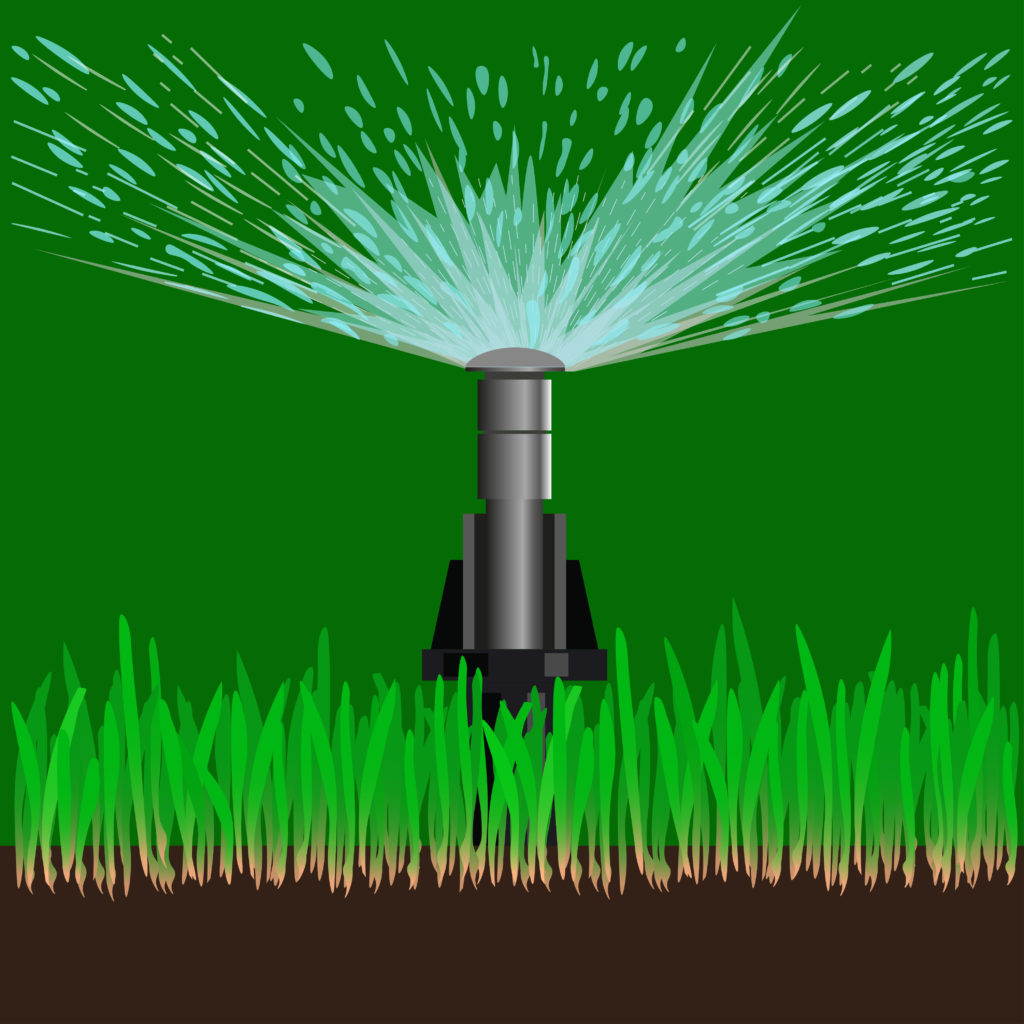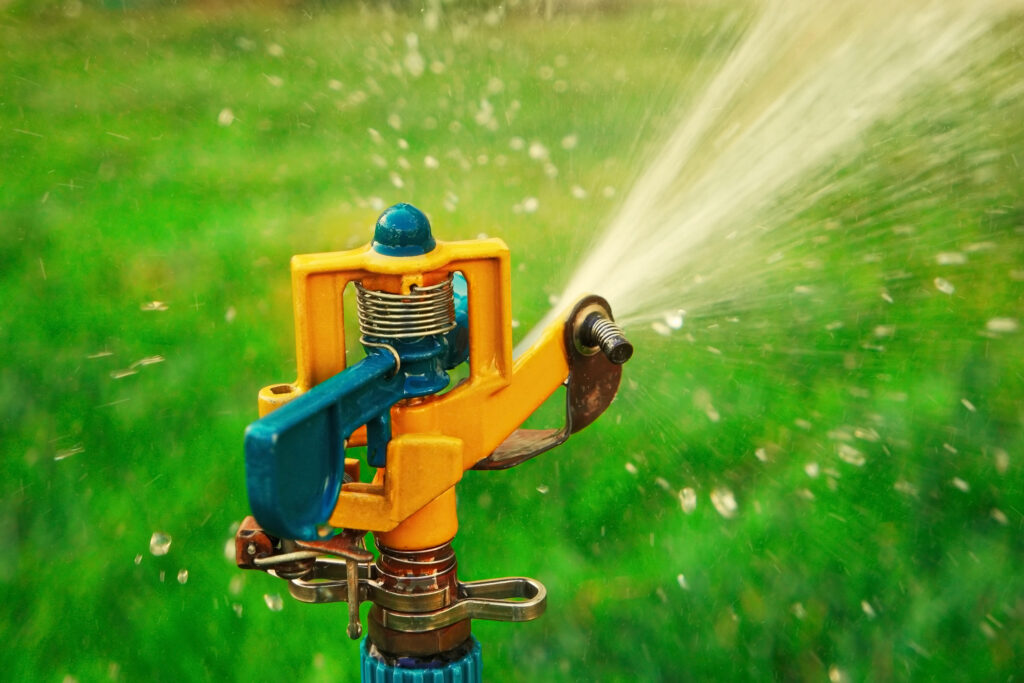
Sprinkler systems are a great way to make your lawn look lush and green, but if you have ever had one break down or not turn on at the right time, it can be frustrating. Whether your sprinklers just aren’t working or they’re constantly going off when you don’t want them to, we will go over some of the most common troubleshooting steps for when your sprinklers aren’t working properly.

How to Fix a Sprinkler Head That Won’t Rotate
To fix a sprinkler head that won’t rotate, troubleshoot by adjusting water pressure, clearing obstructions, inspecting for debris, and examining parts for misalignment or damage. Consider installing a water pressure regulator for high-pressure issues. Ensure proper positioning on even surfaces or build platforms for steep inclines. Regular cleaning and maintenance can prevent future problems and optimize irrigation efficiency.
Common Reasons Why Your Sprinkler Head Isn’t Rotating
Your faulty sprinkler rotary function can be caused by debris, low water pressure, installation errors, broken/clogged sprinkler heads, and faulty controllers.
Obstructions
Too much debris can cause the sprinkler not to function properly. An obstructed or clogged sprinkler is one of the common problems behind why is my sprinkler not turning.
There might be something blocking the sprinkler head’s path. This can include stones, small plants, tree branches, or even just dirt. Eventually, your sprinkler head will stop rotating if it is constantly stopped.
If this is the case, make sure sprinklers are in good working order and that obstacles are regularly removed.
Inadequate Water Pressure
For the valve to move, it needs some strength. Too little water pressure will prevent the water from circulating around the perimeter completely. Similarly, if there is excessive pressure, it won’t be able to handle the pressure and will malfunction.
Make sure your water pressure is sufficient, the faucet is operating properly, and you have control over the water flow from the faucet. Use a pressure gauge to check if your sprinkler is working under ideal pressure.
Error While Assembling
We make this mistake a lot with our sprinklers. During assembly, we force everything together with the hope that it will work out. Initial results might be positive, but you will soon run into trouble.
The trick to this is to be patient and steady. Follow the directions carefully and assemble slowly. A slow, long-lasting process is always better than a quick, hasty one.
There are several ways to fix it depending on the region behind it. It may be a good idea to replace sprinkler heads, though, if you are not a technical person.
Spray Heads That Are Broken
In case your sprinkler head isn’t popping up or it pops up and suddenly spouts water everywhere, it may be completely broken. It often breaks when cars or lawnmowers run over it. If you have broken sprinkler heads, find the correct sprinkler heads to match your irrigation system.
The Sprinkler Controller Stopped Working
Several things can cause your controller to stop working including the timer not set correctly, the timer dial not turning, the controller not turning in the manual mode, or the controller doesn’t work in automatic mode.
A Clogged Sprinkler Head
It is possible that the sprinkler head is clogged if it does not rise and no water is flowing. Sprinkler head filters accumulate sand, dirt, and other debris. Clean the filter by turning off the water, lifting the riser, removing the pop-up nozzle, cleaning the filter, and then replacing the riser.
What Should You Do If Your Sprinkler Head Doesn’t Rotate?
Sprinkler heads that have a broken rotary function will result in an uneven water flow. There are many factors that you can look into to fix the issue, and we have a detailed list of these fixes that you can apply to repair your broken sprinkler. Some of the common ones are adjusting the water pressure, checking for possible obstructions, change gears, checking for dirt and debris lodged in the system, check if the sprinkler system is installed on a steep slope, and lastly, examining the whole sprinkler system for broken, misaligned, or worn off parts.
We’ve listed what steps you can take as a homeowner and how you can fix your sprinkler depending on the issue.
Obstructions
To avoid interference with any possible obstruction, raise the sprinkler using sticks or place it on a stable, even surface. As well as making sure the location is clear of grass and tall plants, it’s also essential to ensure that there are no obstacles. Without elevating the sprinkler system from such obstructions, you may end up damaging it permanently.
Volume or Pressure of Water
A faulty sprinkler system that does not have enough water pressure is less likely to move. It may also move very slowly or not be able to circle its arc as fast as you would like. Sprinkler heads require varying amounts of pressure to rotate.
Alternatively, if the pressure becomes too great, the sprinkler may not work due to the dislodgment of moving parts. Frequently, high pressure increases friction, which wears out these parts and eventually dislodges them, which might explain why your sprinkler head appears to be moving erratically.
It may be water pressure that is causing your sprinkler head to not turn as it should. Observe any differences in the sprinkler pressure if you drop or increase the water pressure on the tap or faucet. It might be worth replacing your sprinkler system if it does not operate properly under low pressure for a small yard or garden.
In other cases, water pressure from your faucet might be too high and prevent the sprinkler head from turning. Fortunately, it can be corrected by installing a water pressure regulator to bring it down to a reasonable level. Most domestic water supplies are set at 50-60 PSI, which should be adequate. The only exception is if the water pressure readings are above this, you should get a regulator instead of a new sprinkler. The cost will be less.
Examine the Parts for Misalignment, Wear, or Broken Parts
You’re good if anything needs to be re-aligned or reset. All it requires is alignment or resetting to its proper position. Trip collars and trip pins are the most critical components. The trip pin should not be easily visible since it is a thin metal pin located at the base of your sprinkler. It is located just above the trip collar.
The Gears
When changing nozzle patterns or rotation speeds, change only the gears designated for adjustment and never force the nozzle bar. Put the sprinkler bar in the proper position by letting the water pressure do the work. You don’t have to rotate the bar or cylinder at all.
Connect the sprinkler to the water source and hold it upside down while rotating the head around the arc.
Deflect water spouts with a bucket or board. As you fine-tune the oscillator, the spurts should show the direction of the water, and for that, you can adjust the head and rotate it two or three times.
Whenever there is no water supply connected to the sprinkler, wait until the sprinkler head is near vertical. Once this is done, it would be safe to adjust the next patch of your garden or lawn as you would like.
Debris In The Sprinkler Parts
A clogged sprinkler head cannot be turned since water can’t reach it if the sprinkler is in any way obstructed. There might be times when a clog will reduce the spray water range of a sprinkler. In areas surrounding the head, you will probably notice it is marshy while the other areas are dry.
Ensure there is no dirt and debris on the swivel, bearing, or inlet of the sprinkler head. Remove the sprinkler head carefully. To check for debris inside the nozzle, insert a small needle, nose pliers, or a pin so that it can loosen and be removed.
Take care not to damage the nozzle. Brutal drilling could permanently damage the nozzle, which could be costly. To prevent any grease and dirt from sticking to the head, clean it thoroughly afterward. Use a vinegar and water solution for this task.
Take your time cleaning the solenoid valve. Using a screwdriver, unscrew the control valve box so that you can access the component. It should be cleaned up and bolted back if there is dirt and debris inside.
Steep Incline
When you install your sprinkler on a steep slope, the arc around the head would be significantly compromised, and the head might not rotate at all.
Sprinklers placed on uneven surfaces will affect their tolerance. While minor tilts are not a problem, don’t tilt it too far (more than 15° or so).
You can build a platform to level out the slope of your garden or lawn if it is uneven.
For the sprinkler legs, use PVC pipes or even a flat wooden piece. These are not difficult projects. Neither are special tools required. The sprinkler only needs to be positioned evenly.
In a sloping garden, a sprinkler can be set either at the top or bottom of the slope, where the surface is even enough if building a platform is not practical for you. It can be moved along that surface to ensure every section is receiving enough water.
Is Your Sprinkler System Not Turning? Let Westside Grounds Handle The Repairs!
Do you need a new sprinkler head? Do you need to maintain the sprinkler system? Have rotation issues? Denver residents seeking a healthier lawn can benefit from the sprinkler repair services, lawn care services, and snow removal services provided by Westside Grounds. Contact us for sprinkler repair whenever you need it!




